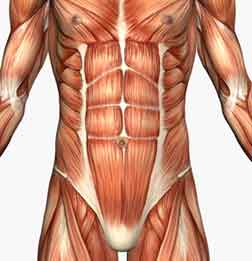
To design an effective abdominal program, you need to separate the hype from the truth. Forget everything you may have found out from TV infomercials. Here we debunk the remarkably persistent myths about abdominal training.
Myth #1: Abdominal exercises get rid of the blubber around your middle
Reality: Ab exercises can’t help you “go from flab to abs,” as many infomercials claim, because flab and abs are separate entities. Abdominal exercises strengthen and tone your muscles, but these muscles lie underneath the layer of fat on top. Spot reducing through toning exercise is a fantasy. The only way to lose your belly fat is to eat less and exercise more — a strategy that reduces your overall body fat. However, even then you have no guarantee that you will lose the fat from your middle.
Myth #2: Everyone can develop washboard abs if they try hard enough
Reality: Even if you make it your life’s mission to eat a low-fat diet, spend hours a day on the StairMaster, and perform abdominal exercises to utter perfection, you still may not develop that rippled look unless your body is genetically programmed to carry almost no fat in the abdominal area. And very few of us are built that way.
Myth #3: For best results, you should do several hundred repetitions of abdominal exercises
Reality: Treat your abs like any other muscle group; in other words, perform 8 to 15 repetitions per set to fatigue for optimal strength and endurance conditioning. To focus on endurance training for the abs, do more reps — up to 24 — to fatigue. If you can do more than this, you’re either doing the exercise incorrectly or you’re performing an exercise that’s too easy for you. Either way, you’re not doing your abs much good.
Myth #4: You need to work your abs every day
Reality: Again, your abdominals are like every other muscle group. They respond best to hard work followed by a day of rest. Overtraining your abs simply invites neck and lower back problems, not to mention boredom. Strength training for your abs, however, is different from endurance training for the core.
Myth #5: The front of your stomach has two separate muscles: The upper abs and lower abs
Reality: The rectus abdominis is one long, flat, continuous sheet of muscle. Any abdominal crunch exercise works the entire muscle, although lifting your upper body off the floor emphasizes the upper portion of the rectus, and lifting your hips off the floor emphasizes the lower portion. When you do ab exercises slowly and with perfect form, you feel the entire muscle working no matter what exercise you do.
Myth #6: You need a gadget to train your abs
Reality: Although ab roller-type contraptions help novices understand the crunch movement, the floor works as well as or better than any device, and last time we checked, the floor was free. Besides, exercises such as the ones shown in this chapter are more challenging and versatile than those performed with a gadget. We’re not fond of health club abdominal machines, either. Most of them strengthen your back and hips more than they do your abs.
Myth #7: Sit-ups are better than crunches
Reality: With any sit-up-type movement, your abdominals are involved only in the first part of the motion. After your shoulders clear the floor, your hip flexor and lower back muscles take over. So there’s no point in sitting all the way up to your knees.


